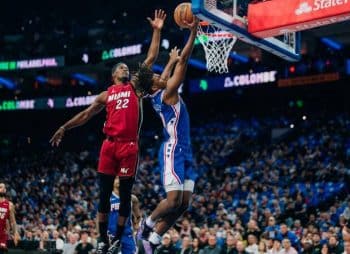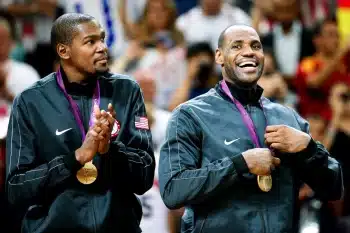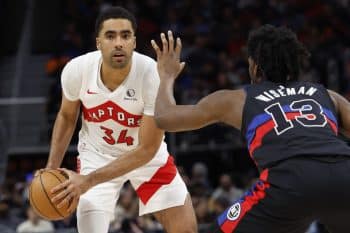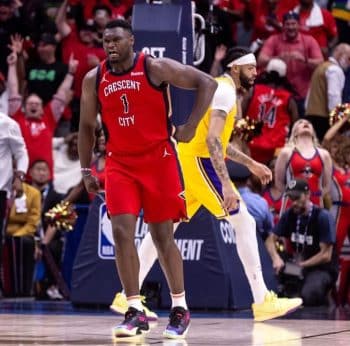NBA
NBA AM: Cavs Struggles About Breaking Old Habits

Systemic Revolt: A 1-3 record to start the season isn’t exactly what Cleveland Cavalier fans signed up for. When LeBron James opted to return to Cleveland and the team made moves to change the team from a youngster laden roster to a veteran filled squad, the idea was to dominate and contend for a title. A 1-3 start wasn’t part of that plan.
Four games does not make a season, but how the Cavaliers are playing has to be concerning.
After the loss to Portland, the storyline was that James was being somewhat passive and letting the young guys learn some hard lessons. The first lesson being that James wasn’t there to save the day, that they would have to work together to be a great team.
Last night James donned the super hero cape and knocked in 31 points and was a perfect 12-of-12 from the foul line. However, his squad still lost to a Utah Jazz team that had four players in double figures and shot better than 50 percent from the field and better than 33 percent from the three point line.
This isn’t exactly what they signed up for, but 1-3 is exactly what they have earned on the floor.
It’s clear that the Cavaliers are going to need more time to figure out how to play a winning brand of basketball, and while James seems to be letting his team figure some things out, the Cavs are digging a hole that may come back to haunt them at the end of the season when playoff seeding is decided by just a small handful of games.
Four games does not a season make, but things are not wine and roses with the Cavaliers.
After their loss in Portland, James blamed his team’s struggles on “bad habits” clearly pointing at the remaining young guys on the team.
“There’s a lot of bad habits; a lot of bad habits have been built up over the last couple of years, and when you play that style of basketball it takes a lot to get it up out of you,” James said to Dave McMenamin of ESPN.com.
Last night he praised Kyrie Irving’s aggressiveness but pointed to his team’s six total assists as another part of the problem.
“He made all the shots we needed to keep us in the game. He made some great plays down the stretch, finished above the rim. It was great,” James said.
The assists were still an issue.
“There’s no way you’re going to win a basketball game like that, just having six assists,” James said. “We had two in the first half, we had four in the second half and we had actually four [total] until the last minute and a half of the game. We just can’t win like that, and we got to figure out a way to help each other and not make it so tough.”
Cavaliers big man Tristan Thompson was a bit more direct after his team’s consecutive loss.
“Our energy level was terrible the whole game,” Thompson told Chris Haynes of the Northeast Ohio Media Group. “We didn’t start picking it up until the last eight minutes probably. So we have to live with the results.
“I can’t put my finger on it but we got to figure it out collectively as a group. It can’t just be one or two guys. It has to be all of us collectively as a group, figuring out what it takes to play 48 minutes of hard basketball, playing with some heart, some balls and being ready to fight.”
The Cavaliers get an off day today, and will face the 1-3 Denver Nuggets on Friday.
KJ McDaniels’ Gamble Looks Smart: Most second round picks negotiate the terms of their rookie deal settling in on something that gives them some level of guaranteed money, but often ties up their rights in a deal that is usually very team-friendly. Second round picks usually don’t have a ton of leverage and more and more teams are crafting four-year deals with lots of team options that usually favor the team a lot more than the player.
For K.J. McDaniels of the Philadelphia 76ers, that’s exactly what the team was offering. A deal that would have locked him into a minimum NBA wage for likely the next four years, but under the 76ers’ terms, with very little guaranteed beyond his first year.
Some might see a four-year deal as favorable, but McDaniels and his agents knew that he was more of a first round talent that slid in the draft than your typical second rounder. McDaniels rolled the dice that he could have a solid season in Philly and force a better deal next summer and accepted the 76ers’ tender offer, which is basically a minimum deal with no guarantees.
McDaniels, by virtue of taking the offer, will be a restricted free agent next summer. It’s unlikely that a team throws crazy money at McDaniels, but he is in a position to receive an offer that likely will be significantly greater than what the 76ers had on the table. More importantly it will likely include guarantees that McDaniels’ agent crafts and will shift not only the monatry parts of the deal more in his favor, but also the control over his future.
As things stand today McDaniels leads the rookie class in PER (14.42) and is third in scoring with 9.6 points per game, trailing top picks Jabari Parker (10.0) and Andrew Wiggins (9.8).
In 2010 undrafted rookie Wesley Mathews landed a five-year, $33.4 million contract from the Portland Trail Blazers after a strong rookie campaign with the Utah Jazz. Former Sixer Lavoy Allen landed a two-year, $6 million extension in 2012 with the 76ers after agreeing to a one-year minimum deal similar to McDaniels.
Those are the scenarios McDaniels’ camp was betting on when they agreed to his current deal.
The 76ers will have the right and the cap space to match anything McDaniels is offered next summer, so there is little risk of losing him. The question is what is his value going to be and will a home run contract in July change how aggressive future second round picks are when it comes to signing some of these very one-sided second round contracts.
Naming Rights For The D-League?: The NBA Development League has a few things going for it. The new television deal the NBA struck with its media partners includes a lot more D-League coverage, which will help the league generate more attention and ultimately more revenue and sponsorships.
That’s a key and important component to the league’s growth and its ability to compensate players. As things stand there are three tiers of compensation for players playing in the D-League. “A” tier players earn roughly $25,000 per season, while “B” tier players earn roughly $19,000 per season with “C” tier players earning just $13,000 per season.
The now completed D-League Draft featured ten “A” tier players including the likes of Joonas Caven, Robert Covington, Andre Emmett, Carrick Felix and Erik Murphy. The ten “B” tier players included names like Kevin Anderson, Michael Dunigan and Robert Vaden. The remaining 155 draft eligible players were all “C” tier players, scheduled to earn in a season what a lot of players earn in a single day. To be fair, most of those “C” tier players will likely never play in the NBA. However, the number of low-wage D-League guys is far greater than those making the top end of the pay scale.
A key to changing that might be the next big experiment the NBA is looking at, and that’s a naming rights deal for the league, much like NASACR has done with its various levels of racing.
According to NBA commissioner Adam Silver, the NBA is exploring opportunities in which a single brand sponsor could own the title sponsor rights to the league, much as Nationwide Insurance has sponsored NASCAR’s second-tier racing circuit.
“For the D-League to go to the next level, one of the top items on our agenda is potentially selling a naming-rights deal for the league,” Silver told Jeff Zillgitt of USA TODAY Sports.
The D-League currently features 18-teams, with 17 of those teams having a direct one-to-one relationship with their parent NBA team either by way of outright ownership or by way of what’s called “hybrid” relationships where the associated NBA team pays for and controls the basketball operations side, while a private owner handles selling the product in their respective markets.
NBA sources say teams that own their own teams spend just under $2 million a season operating a team, which in the grand scheme of things is relatively a small amount of money considering how much comes out of those teams not just in developing players, but in developing staff and potential coaches, scouts and front office personnel.
The ultimate goal for the D-League is a direct one-to-one relationship with all 30 NBA teams. There is no shortage of interest on the NBA side, however the NBA and the D-League are being careful and strategic in expanding the league to insure there is not over saturation too quickly and that the product they are crafting can grow and develop.
With more money flowing into the NBA and into the D-League specifically, the ability increase compensation will help the league field better players who are opting for international markets that pay better.
A title sponsor deal will help, as will the D-League’s expanded presence on television by way of the new right deal.
Sources close to the process peg the D-League as the compromise the NBA will put on the table to secure Commissioner Silver’s desire for an increased age limit to enter the NBA, with increased funding for the D-League as a potential carrot to get the Players’ Association to agree to the change.
A 30-team league, offering wages comparable to the average International wage, featuring games that are nationally televised with major brand sponsorships is the end goal.
Time will tell how fast all of that actually happens, but a naming rights deal would be a huge step in that direction.
More Twitter: Make sure you are following all of our guys on Twitter to ensure you are getting the very latest from our team: @stevekylerNBA, @AlexKennedyNBA, @LangGreene, @EricPincus, @joelbrigham, @SusanBible @TommyBeer, @JabariDavisNBA , @NateDuncanNBA , @MokeHamilton , @JCameratoNBA and @YannisNBA.











